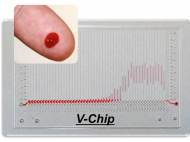V-chip pocket test measures 50 things in a drop of blood
 Up until recent years, blood tests have been performed on large, complex, and expensive equipment such as mass spectrometers, or require fluoroscopy analysis which must be done in a lab, but various groups of researchers are developing low-cost and portable solutions. Researchers at The Methodist Hospital Research Institute and MD Anderson Cancer Center developed V-chip – a device about the size of a business card which needs only one drop of blood to allow 50 different tests in one go.
Up until recent years, blood tests have been performed on large, complex, and expensive equipment such as mass spectrometers, or require fluoroscopy analysis which must be done in a lab, but various groups of researchers are developing low-cost and portable solutions. Researchers at The Methodist Hospital Research Institute and MD Anderson Cancer Center developed V-chip – a device about the size of a business card which needs only one drop of blood to allow 50 different tests in one go.
“The V-Chip could make it possible to bring tests to the bedside, remote areas, and other types of point-of-care needs”, said Lidong Qin, Ph.D., Nanomedicine faculty member and the principal investigator of the project. “V-Chip is accurate, cheap, and portable. It requires only a drop of a sample, not a vial of blood, and can do 50 different tests in one go.”
The V-chip (volumetric bar-chart chip) is composed of two thin pieces of glass, about 7.5x5cm (3 x 2 inches). There are four wells with different elements which are initially separated. The first well is used to store hydrogen peroxide, the second well is used to store up to 50 different antibodies to specific proteins, DNA or RNA fragments, or lipids of interest, and the catalase enzyme. The third well is used to store serum or other sample, and the forth well is used to store a desired dye. A shift in the glass plates brings the wells into contact, and creates creating a connected zig-zagged space from one end of the V-chip to the other.
As you can guess due to V-chip’s components, the testing process approach acts like enzyme-linked immunosorbent assay (ELISA) test. As the substance of interest binds to reagents bound to the glass slide, catalase is made active and splits nearby hydrogen peroxide into water and oxygen gas. The more present the substance of interest is – the more oxygen is created. Since the oxygen pushes the dye up the column, the more present the substance of interest is – the farther dye is pushed up the slide.
Tests show that distance is more or less proportional to the amount of measured substance of interest. The end result is a visual bar chart which is accurate and easy to read. Health care providers could use V-chip to test for insulin and other blood proteins, cholesterol, and even signs of viral or bacterial infection all at the same time. Methodist Hospital Research Institute and MD Anderson Cancer Center researchers plan to improve it to be even more precise and easier to use.
“The sensitivity of the V-chip can be improved if narrower and longer bar channels are used”, said Qin. “Our next steps are to make the device more user-friendly and be so simple to use, it barely needs instructions.”
For more information, you can read the article published in the Nature Communications: “Multiplexed volumetric bar-chart chip for point-of-care diagnostics” [2.38MB PDF].









WHERE CAN WE BUY THE V-CHIP ?
author
I don’t think it has been commercialized yet, but you could contact principal investigator Lidong Qin for more information:
– his Methodist Hospital Research Institute page
– his LinkedIn page
– his Facebook page